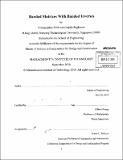| dc.contributor.advisor | Gilbert Strang. | en_US |
| dc.contributor.author | Srinivasa Gopala Raghavan, Venugopalan | en_US |
| dc.contributor.other | Massachusetts Institute of Technology. Computation for Design and Optimization Program. | en_US |
| dc.date.accessioned | 2011-03-24T20:23:10Z | |
| dc.date.available | 2011-03-24T20:23:10Z | |
| dc.date.copyright | 2010 | en_US |
| dc.date.issued | 2010 | en_US |
| dc.identifier.uri | http://hdl.handle.net/1721.1/61896 | |
| dc.description | Thesis (S.M.)--Massachusetts Institute of Technology, Computation for Design and Optimization Program, 2010. | en_US |
| dc.description | Cataloged from PDF version of thesis. | en_US |
| dc.description | Includes bibliographical references (p. 99). | en_US |
| dc.description.abstract | We discuss the conditions that are necessary for a given banded matrix to have a banded inverse. Although a generic requirement is known from previous studies, we tend to focus on the ranks of the block matrices that are present in the banded matrix. We consider mainly the two factor 2-by- 2 block matrix and the three factor 2-by-2 block matrix cases. We prove that the ranks of the blocks in the larger banded matrix need to necessarily conform to a particular order. We show that for other orders, the banded matrix in question may not even be invertible. We are then concerned with the factorization of the banded matrix into simpler factors. Simpler factors that we consider are those that are purely block diagonal. We show how we can obtain the different factors and develop algorithms and codes to solve for them. We do this for the two factor 2-by-2 and the three factor 2-by-2 matrices. We perform this factorization on both the Toeplitz and non-Toeplitz case for the two factor case, while we do it only for the Toeplitz case in the three factor case. We then look at extending our results when the banded matrix has elements at its corners. We show that this case is not very different from the ones analyzed before. We end our discussion with the solution for the factors of the circulant case. Appendix A deals with a conjecture about the minimum possible rank of a permutation matrix. Appendices B & C deal with some of the miscellaneous properties that we obtain for larger block matrices and from extending some of the previous work done by Strang in this field. | en_US |
| dc.description.statementofresponsibility | by Venugopalan Srinivasa Gopala Raghavan. | en_US |
| dc.format.extent | 99 p. | en_US |
| dc.language.iso | eng | en_US |
| dc.publisher | Massachusetts Institute of Technology | en_US |
| dc.rights | M.I.T. theses are protected by
copyright. They may be viewed from this source for any purpose, but
reproduction or distribution in any format is prohibited without written
permission. See provided URL for inquiries about permission. | en_US |
| dc.rights.uri | http://dspace.mit.edu/handle/1721.1/7582 | en_US |
| dc.subject | Computation for Design and Optimization Program. | en_US |
| dc.title | Banded matrices with banded inverses | en_US |
| dc.type | Thesis | en_US |
| dc.description.degree | S.M. | en_US |
| dc.contributor.department | Massachusetts Institute of Technology. Computation for Design and Optimization Program | |
| dc.identifier.oclc | 706817431 | en_US |
